Looking for art at the edge? April is woodworking month and surprises abound. This is not your grandpa’s woodwork. Though plenty of woodworkers are, in fact, grandpas, the work they’re creating is anything but predictable.
Current exhibits at Grovewood Gallery and Blue Spiral include everything from turned bowls translucent as glass to furniture that provides psychological support for the indecisive.
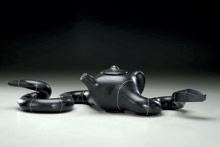
And not all woodworkers are guys. Asheville woodworker and sculptor Sylvie Rosenthal’s conceptual furniture is bursting through the traditional boundaries that separate craft and art. Some of the most exciting art that’s happening in Asheville—or anywhere—is coming from the craft sector.
These exhibits may ruffle the feathers of some traditional woodworkers who prize low-key functionality that stays close to the material. Or not. “It just depends on your theology,” says wood turner Michael Allison.
The new director of Asheville-based nonprofit the Furniture Society is determined to promote the quieter pursuits of traditional furniture makers, who have been a mainstay of the N.C. crafts movement for more than a century. “Art doesn’t have to be about hitting you over the head with some angst-laden message,” says David Edgar.
For Brent Skidmore, Director of UNCA’s fledgling Craft Campus, craft is about community and self-transformation. “When you have people making things and using their hands—that’s powerful. Something changes in you when you use head, hand and heart to make something,” he says. “You add something to the community.”
Another thing craft adds to the community in Western North Carolina is money. According to a recent economic impact study conducted by a consortium of the state’s craft organizations, professional crafts in this region are a growth industry that generated $206.5 million in 2007.
What would happen is a snake swallowed a teapot?
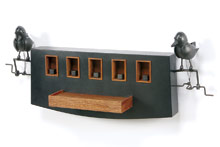
Sylvie Rosenthal began her artistic career as an exuberant five-year-old in the summer program at the Eli Whitney Children’s Museum in New Haven, Conn.
“I made robots, boats, circuses, little working factories, little people. We were always combining a lot of different things,” Rosenthal says.
She clearly treasures this early experience, and she seems to relive it in her current work, which is full of curiosity, enthusiasm and a sense of fun. “Le Serpent Qui Mange la Theiere Deux” was Rosenthal’s response to an invitation to participate in a teapot show.
“I knew I wasn’t going to make a functional teapot. Then somehow I thought about The Little Prince. What would happen if a snake swallowed a teapot?” she muses. What happened was an intriguing piece of art.
Rosenthal likes snakes and birds, and they appear frequently in her work, along with boats, dice, chairs and living spaces. Like images that turn up over and over in dreams, these references call up feelings, suggest ideas, seem full of meaning and yet elude interpretation.
According to Rosenthal, the “frankenbirds” in “Yes, Yes, Oh No” help with decision-making: you turn the crank for answers, which are inscribed on little dice. She also makes the moving metal parts of her contraptions.
A new piece in a series of “Hope Chests” is not intended to be a functional hope chest. Instead it celebrates the idea of a hope chest. “It’s important to have small, medium and large hopes,” says Rosenthal, referring to the diminishing size of the chests. And there are those birds again.
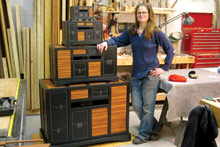
After completing a B.F.A. at the Rochester Institute of Technology, Rosenthal moved to North Carolina to work with a mentor, Doug Sigler, who was building artisan homes in Mitchell County. He made sure Rosenthal continued her craft. Last year, she earned a competitive $10,000 fellowship from the N.C. Arts Council.
Leaving her studio, she talks about making pie safes. “I just like the idea of a pie safe,” she explains. Then she’s captivated by the modeling on the plastic headlight of my Scion. “Interesting,” she murmurs. You can almost see the wheels of her imagination turning.
Sylvie Rosenthal’s work is on view at Blue Spiral Gallery in the Wood National Invitational through April 25.
From making guitars to pushing limits
“Mom—this is wood?” exclaims a young viewer looking at Michael Allison’s work in the current exhibit at Grovewood Gallery, Turning to the Future: A Fresh Look at Wood Art.
Allison, like many of the artists in this exhibit, is pushing wood to its limits. Allison dyes the wood and uses unique finishes to create vessels that look more like glass than wood. He got the idea from his years as a musical instrument maker.
“Everyone says ‘I’ve never seen anything like this before.’ I guess they never looked at electric guitars from the ‘50s,” Allison quips.
Allison says he takes some flack from fellow woodworkers who question whether his treatment of the wood respects the material. But Allison works with found wood and firewood, which isn’t all that exotic in Connecticut where he lives. He believes his dyes accentuate the beauty of ordinary woods like ash and maple.
This exhibit presents a range of remarkable pieces. Irene Grafert’s bowls defy gravity with their lightness and fragility. Steven Hatcher’s “Search for Clarity” is inlaid with crystals so it glows from within. Ed Kelle’s turning looks more like coral than wood. Binh Pho’s painted pieces present mystical landscapes. Englishwoman Joey Richardson creates amazingly intricate scenes by piercing, carving and airbrushing sycamore.
Some of the most elegant pieces, like Tucker Garrison’s “Bird’s Nest,” combine innovative techniques with the traditional “brown and round” woodturning aesthetic.
Jim Keller’s stunning “Bugatti, Evolution of the Wheel” was made from a mesquite burl retrieved from someone’s yard. This retired civil engineer, who describes sculptors and woodworkers as “the original recyclers,” takes a more traditional approach to wood. He’s intent on revealing the natural qualities of the wood.
“I like to work with the burl of a tree because of the intertwining grains. You find fantastic patterns,” Keller says.
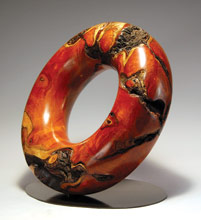
This show gives a rare glimpse into the artistic potential of wood. “Wood as a medium, is a baby,” Allison says. “It’s in its infancy as an art form. There’s some exceptionally adventurous stuff going on in wood, but it’s below the radar.”
Turning to the Future: A Fresh Look at Wood Art will be on display at the Grovewood Gallery through May 11. See photographs of the exhibit at www.grovewood.com.
Are chairs just for sitting?
The new director of the Asheville-based Furniture Society, David Edgar, describes himself as “ambi-hemispheric”—the somewhat rare individual who can use both sides of his brain, one to make art and the other to navigate the business end of the art world.
Edgar says furniture is easy to take for granted. Unlike mind-bending fine art or glitzy craft innovations, good furniture is by nature functional, understated, elegant and inconspicuous. The former professor of sculpture and arts administration is determined “to make visible an art form that is otherwise invisible.”
In June, hundreds of makers will descend on Appalachian State University for the society’s annual conference, “Industrious: The Design, Craft and Commerce of Furniture Making.” The conference will stress production and marketing.
Appalachian State has maintained a furniture-making program since 1899. It was originally designed to provide talented workers for the state’s extensive furniture industry, but now the program focuses on design. North Carolina is home to over one hundred furniture manufacturers and a national hub for hand-crafted furniture.
Edgar hopes the conference will create a sense of community and belonging for furniture makers. “It’s not a lifestyle that’s full of collaboration,” he notes.
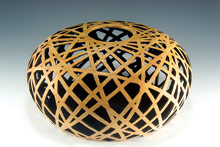
One of the conference highlights is an auction of work by presenters and participants. “I’m astounded by the quality and scale of the work donated to the auction,” says Edgar. Tickets for the auction are $50.
Jacque Allen, who has been a member of the Furniture Society for six years, is donating work to the auction. She honed her skills in Haywood Community College’s professional craft program.
“The furniture society is a great way to meet other furniture makers. People come from all over the country and the world. Everyone loves it,” Allen says. She will be showing work in the upcoming Are Chairs Just for Sitting? exhibit at the Center for Craft, Creativity and Design.
The fact that many of the conference presenters are young and female suggests that the Furniture Society is attracting new members and spreading the craft beyond its traditional boundaries. The Society offers grants through Powermatic for students and emerging makers to attend workshops at Penland and several other craft schools.
But Edgar believes there is still more work to do. “We need more young people in the pipeline if we want to see the craft continue,” he says.
To learn more about the Furniture Society, the upcoming conference or scholarship opportunities, visit www.furnituresociety.org. Are Chairs Just for Sitting? opens May 5 at the Center for Craft, Creativity and Design.
[Harriette Grissom can be reached at harriettegrissom@bellsouth.net.]
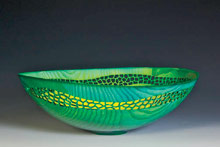

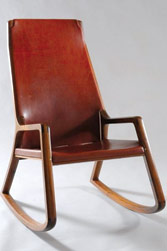
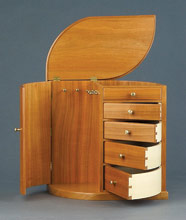



” . . a growth industry that generated $206.5 million in 2007 . . .”
What does it mean to say that the industry “generated” $206.5 million? Is this new money coming into the region that would not have otherwise come in? Does it mean that craftspeople earned this amount in total revenue? Does it mean the amount craftspeople spent in their businesses? Can an economist explain?
Wow… and I thought I was crafty when I made my own poker table…. cool stuff.
Can journalists come up with anything different from “Not your grandpa’s….” fill in the blank to indicate new and exciting trends in, well anything! If it weren’t for our grandpa’s woodwork–which was innovative in its time–new craftspeople would still be carving points in sticks. And to start out with “not your grandpa’s woodwork,” then go on to tout Sylvie Rosenthal’s work is adding insult to injury. You’ve managed to insult the elderly and women all in one blow. Congrats.
Great article, and this is just the beginning. Furniture and wood working events and opportunities continue throughout the spring in western NC. For more information check out http://www.handmadeinamerica.org/focusonfurniture.